Digging deeper into a Solar Design
My last article covered a lot of material. I realized later there is even more detail to be uncovered. We need more data to make many decisions which will be long-term. In this article, I dig deeper in an attempt to finish my design. I also cover the question of Time of Day Pricing and how it affects a utility bill.
Much remains hidden beneath the surface.
The first thing I decided to tackle was finding out exactly how much power would be generated by my solar system. This is essential to know because only if you find out the MAX it will generate, would you know the shortfall, and then figure out how to deal with it (ex: Batteries). So, I did some digging online and found this:
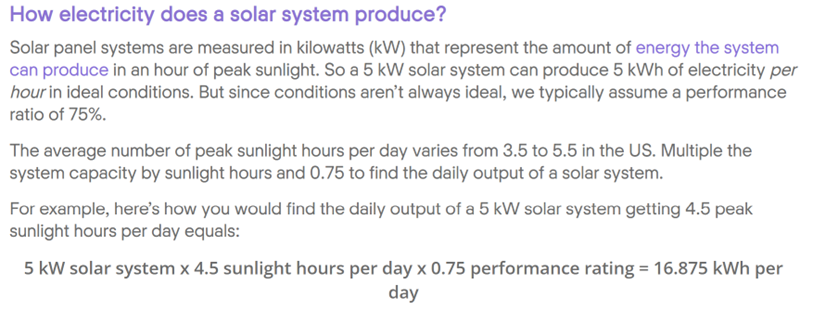
|
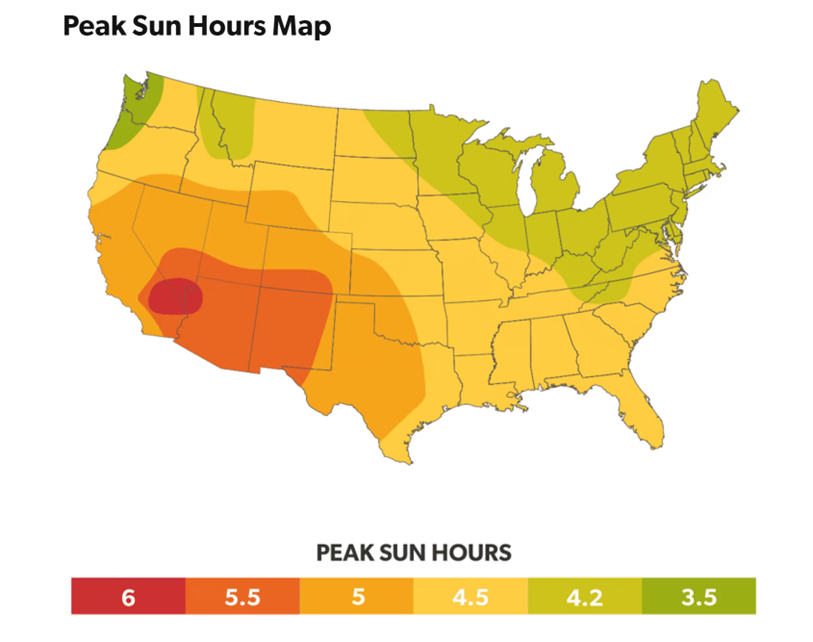
|
Then, I found a website, which let me enter my address and gives me the average sunlight for the whole year, along with month to month numbers as well. My average is 3.96 hours, which is honestly not a lot of hours. Using the formula, I created a table which shows my month by month solar production per day with 33 and 36 panels, my utility usage for that month in the past year, and the shortfall. You will also notice that I looked at MIN and MAX numbers as well, when I considered how many batteries I would need to meet the shortfall. Some of the winter usage numbers are very high because we mistakenly used space heaters instead of gas heating last year because I got scared by the gas bills. We won't make that mistake this year!
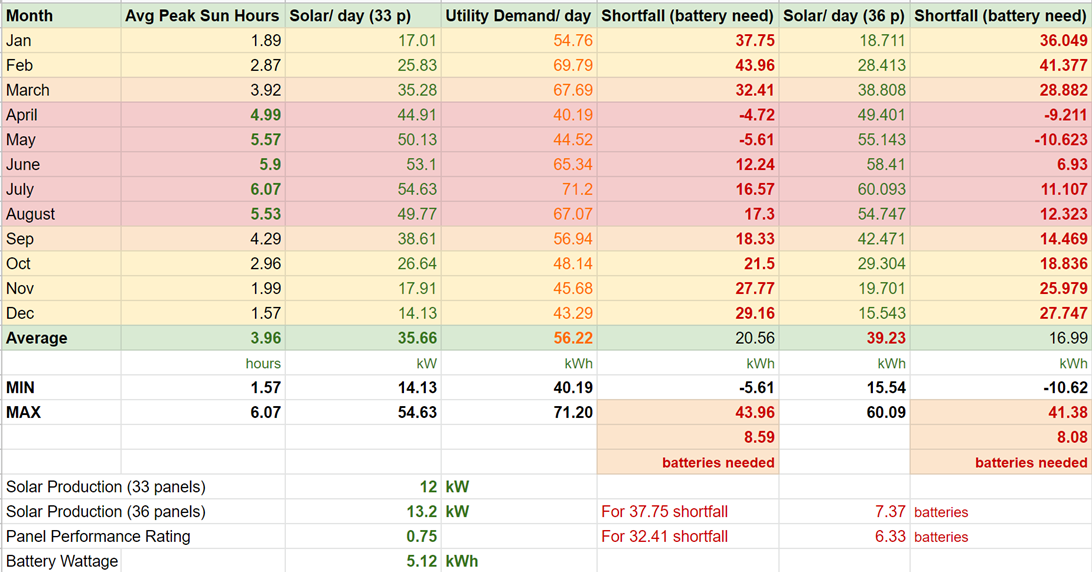
In the meantime, the manufacturer of the inverter confirmed that SOL = SUB in terms of the Output source priority, and it is the same thing, just a difference in language. Meaning that the battery would always kick in before the utility. So, I spent a long time, trying to figure out a scheme wherein, I could make the Grid power the shortfall demand, instead of the battery coming in between (because I don't have that many batteries to begin with). So here is what I had to work with (from the manual):
"Utility provides power to the loads only when any one condition stated below happens: - Solar energy is not available - Battery voltage drops to either low DC warning voltage or the setting point in program 12."
The idea was to set the voltage to such a threshold that the Grid would always take over. I tried one approach which failed, which is shown below. The problem with keeping the value high is that the battery would charge up too quickly from that very high value, and the grid would charge it fast again, and it would keep switching frequently between the grid and the battery.
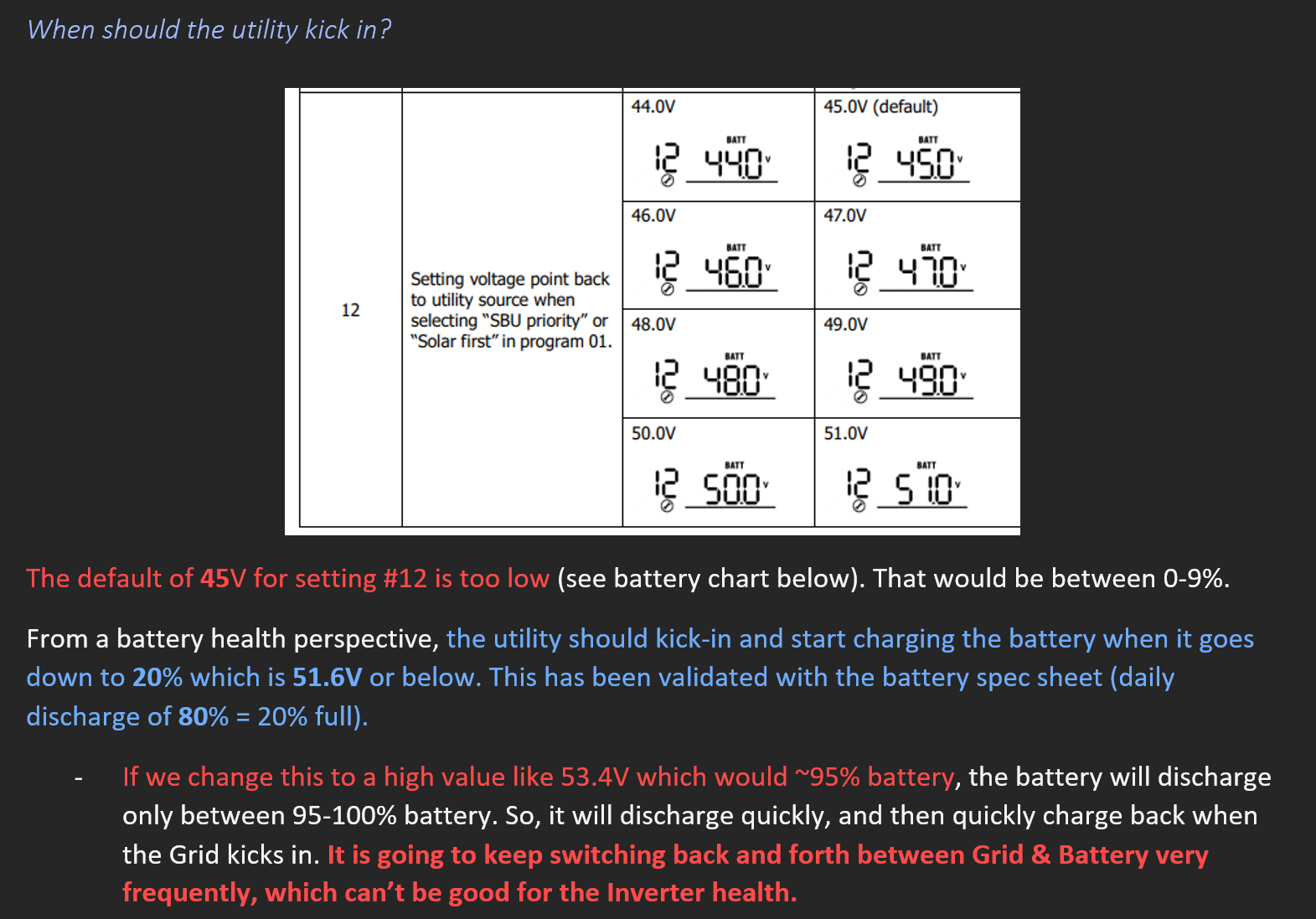
It took me a day to figure out the alternative approach which I believe will work for me. In this approach, we set the grid to kick in when the battery is 50%, but it will rarely hit that number because it is only charged by solar. And solar can barely keep up with demand to charge the battery. This means that I would not be charging the battery with utility power and the battery would charge slow enough that the system would run mostly on solar and grid most of the time. The icing on the cake is that I would not have to get a lot of batteries in this scenario and I could save $$$. I admit, I would not be able to run heavy loads with fewer batteries charging slowly, and during the very rare grid outage, I would have little backup power - but I rarely lose power so that is not a problem for me.

The battery would kick back in only when it got to 100% charge (see setting 13 below), and it would discharge to 50% before the Grid would kick back in again. Note that for the charger source priority, I do have the option of using CSO mode, where utility charges the battery when solar is NOT available. It seems to be perfect, but the problem is that between 4:00 pm - 7:00 pm est in the winters, the utility would charge the battery during peak hours, which is not great. So, I needed to analyze the Time of Day service of my Utility company as well.
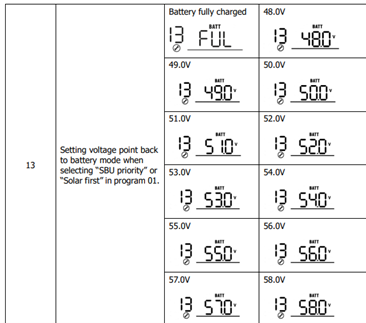
|
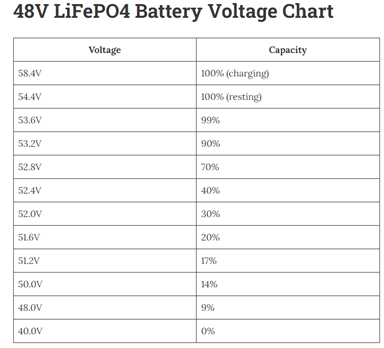
|
The Time of Day analysis was done comparing my current bill and changing the numbers to use either fully off peak or fully peak hours for usage. I found that there are minimal savings with going fully off peak, while the cost was significantly more expensive if all the loads were running during peak hours. Not good for the consumers! So, the other option I would have is to manually change the Charger Source Priority every day as shown below. It is important to note that I would not need to do any of this, if Only Solar can charge my batteries in a decent amount of time, which I still think it can.

To run my whole house HVAC in the summer during the peak hours would require 7 hours X 3,500 watts = 24,500 watt hours, divided by 5.12 kWh for the battery means, I would need 5 batteries just to run my HVAC during the summer peak hours. Bolstered by solar, and maybe adding one more battery to fill my rack, I will probably be able to reduce my utility usage by a lot. It is important to remember that trimming the usage will also help reduce my utility bill, but if we have a horrible summer like 2022, in 2023 all bets are off because of the HVAC usage.
I think that covers it all so far. The only other item to mention is that I may have got a better deal from RICH Solar by purchasing their inverter on Black Friday (MPP was not even available at the time). But at the time of this writing, their inverter may NOT support the Wi-Fi Module which would let me change the inverter settings using an app (I know many people curse the app). So, the plan is then to use the PC app and RDP into the PC to check and modify Inverter Information. I already have an old motherboard with a CPU and some RAM on it. I should be able to put it in a case and connect that to the inverters.
- TJ
Published Dec 2, 2022